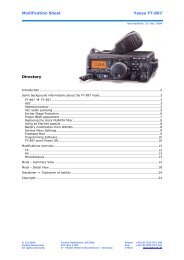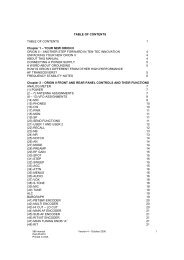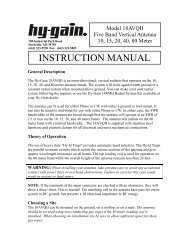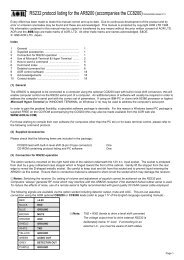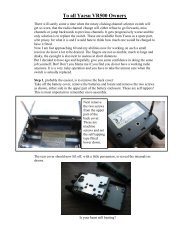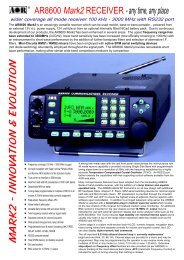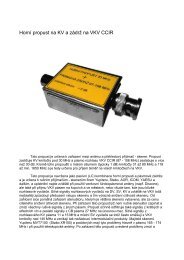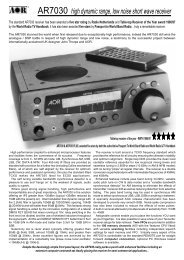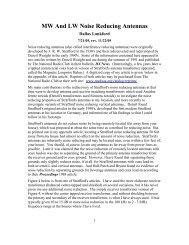Technical Description of the Kenwood Tuner ... - äþруü QRZ.RU
Technical Description of the Kenwood Tuner ... - äþруü QRZ.RU
Technical Description of the Kenwood Tuner ... - äþруü QRZ.RU
- No tags were found...
You also want an ePaper? Increase the reach of your titles
YUMPU automatically turns print PDFs into web optimized ePapers that Google loves.
<strong>Technical</strong> <strong>Description</strong> <strong>of</strong> <strong>the</strong> <strong>Kenwood</strong> <strong>Tuner</strong> InterfaceBy AA4PB<strong>Kenwood</strong> HF transceivers such as <strong>the</strong> TS-50 have a 6-pin tuner interface connector. If a tuner isconnected when <strong>the</strong> radio is first turned on, it senses <strong>the</strong> type <strong>of</strong> tuner attached and configures<strong>the</strong> interface protocol accordingly. If no tuner is attached <strong>the</strong>n <strong>the</strong> radio’s tune function isdisabled. There are two bi-directional TTL level (0 and +5 Volts) lines that provide <strong>the</strong>communications between <strong>the</strong> radio and <strong>the</strong> tuner. These are called TS (Tune Start) and TT (TuneTerminate). These lines are pulled up to +5 Volts by resistors in <strong>the</strong> radio. Ei<strong>the</strong>r <strong>the</strong> radio or <strong>the</strong>tuner can pull <strong>the</strong> lines to ground with an open-collector driver.The <strong>Kenwood</strong> AT-50 tuner uses a serial data communications with commands sent from <strong>the</strong> radioto <strong>the</strong> tuner on <strong>the</strong> TS line and commands from <strong>the</strong> tuner to <strong>the</strong> radio on <strong>the</strong> TT line. <strong>Kenwood</strong>has been unwilling to release <strong>the</strong> exact protocol and commands. One would assume that <strong>the</strong>rewould be a tune command from <strong>the</strong> radio, a bypass command from <strong>the</strong> radio, and a match-foundcommand from <strong>the</strong> tuner. It might be possible to reverse-engineer <strong>the</strong> commands by monitoring<strong>the</strong> ascii data flow on <strong>the</strong> TS and TT lines while operating an AT-50.The <strong>Kenwood</strong> At-300 uses a bi-directional hand-shaking protocol on <strong>the</strong> TS and TT lines. Duringpower-up, <strong>the</strong> radio momentarily pulls <strong>the</strong> TS line low and looks for <strong>the</strong> tuner to respond byimmediately pulling <strong>the</strong> TS line low. If this occurs <strong>the</strong>n <strong>the</strong> firmware in <strong>the</strong> radio is initialized in <strong>the</strong>AT-300 mode and <strong>the</strong> following timing diagrams are followed.
The two traces in each <strong>of</strong> <strong>the</strong> three examples represent <strong>the</strong> voltage present on <strong>the</strong> TS and TTlines (zero or +5 Volts). The indicator to <strong>the</strong> right <strong>of</strong> <strong>the</strong> trace indicates whe<strong>the</strong>r <strong>the</strong> radio or <strong>the</strong>tuner is controlling <strong>the</strong> line. Most <strong>of</strong> this information was taken from <strong>the</strong> <strong>Kenwood</strong> AT-300Maintenance Manual.Normal TuningIn <strong>the</strong> first timing diagram, <strong>the</strong> operator has momentarily pressed <strong>the</strong> tune command and <strong>the</strong>radio is signaling <strong>the</strong> tuner to begin by pulling <strong>the</strong> TS line low (zero volts). The tuner responds bypulling <strong>the</strong> TT line low a short time later. The radio responds to <strong>the</strong> low TT line by outputting a 10Watt CW tune signal. As soon as <strong>the</strong> tuner finds an appropriate match for <strong>the</strong> antenna, it releases<strong>the</strong> TT line back high (+5 Volts). The radio responds by terminating <strong>the</strong> CW tune signal and <strong>the</strong>nreleases <strong>the</strong> TS line back high. The tuning cycle is now complete.Failed or Canceled TuningThe second timing diagram shows what happens if <strong>the</strong> operator cancels a tune in progress bypushing <strong>the</strong> tune button or <strong>the</strong> radio times out after 15 seconds <strong>of</strong> tune signal because <strong>the</strong> tuneris unable to find an appropriate match. To begin, <strong>the</strong> operator momentarily presses <strong>the</strong> tunebutton and <strong>the</strong> radio pulls <strong>the</strong> TS line low. A short time later <strong>the</strong> tuner responds by pulling <strong>the</strong> TTline low and <strong>the</strong> radio transmits <strong>the</strong> CW tune signal. At that point <strong>the</strong> radio starts a 15 secondtimer. If time expires or <strong>the</strong> operator presses <strong>the</strong> tune button again before <strong>the</strong> tuner has found amatch <strong>the</strong>n <strong>the</strong> radio releases <strong>the</strong> TS line back high. The tuner <strong>the</strong>n releases <strong>the</strong> TT line backhigh and places itself in bypass (antenna connected directly to <strong>the</strong> radio).Bypass RequestThe third timing diagram shows what happens when <strong>the</strong> operator presses and holds <strong>the</strong> tunebutton for 2 seconds to place <strong>the</strong> tuner in bypass. This is <strong>the</strong> one case where <strong>the</strong> radio controls<strong>the</strong> TT line and <strong>the</strong> tuner controls <strong>the</strong> TS line (<strong>the</strong>y are both bi-directional, open-collectorcontrolled lines). The radio pulls <strong>the</strong> TT line low to signal <strong>the</strong> tuner to enter <strong>the</strong> bypass mode. Thetuner acknowledges by pulling <strong>the</strong> TS line low. The radio <strong>the</strong>n releases <strong>the</strong> TS line. The tunergoes into bypass and releases <strong>the</strong> TT line. No tune signal is transmitted by <strong>the</strong> radio.Hardware ConnectionsThe <strong>Kenwood</strong> tuner interface utilizes a 6-pin connector as shown below. Note that this view is <strong>of</strong><strong>the</strong> rear <strong>of</strong> <strong>the</strong> connector on <strong>the</strong> end <strong>of</strong> <strong>the</strong> cable that plugs into <strong>the</strong> radio. Information on <strong>the</strong> JSTconnector and distributors can be found at http://www.jst.com
A Quick and Dirty Tune FunctionThe tune button on <strong>the</strong> <strong>Kenwood</strong> radios can be made to function by simply placing a 1K, 1/4-Wattresistor between <strong>the</strong> TS and TT lines. Momentarily pressing <strong>the</strong> tune button will cause <strong>the</strong> radioto transmit <strong>the</strong> 10-Watt CW tune signal until <strong>the</strong> operator presses <strong>the</strong> tune button a second timeto cancel <strong>the</strong> tune. Please note that <strong>the</strong> resistor must be in place when <strong>the</strong> radio is first turned onin order to fool it into thinking <strong>the</strong>re is a tuner attached. This simple method can be used toprovide a manually controlled tune function. The easiest way to fully implement <strong>the</strong> full <strong>Kenwood</strong>tuner protocol, including bypass, will be to develop an interface with a PIC microcontroller.




